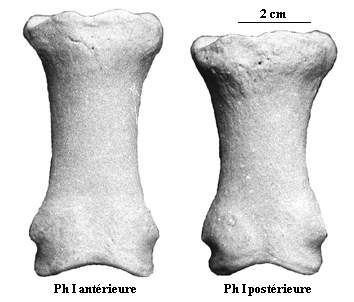Home > Equidae monodactyles > Equus actuels et récemment éteints > 10.Premières phalanges antérieures : PhIA
Differences between anterior and posterior Ph I
The differences are particularly clear on the illustrated pair of phalanges (BO 89482, HP 35) and on most first phalanges of E. hemionus.
– In the same animal, first anterior phalanges are almost always longer.
– On the posterior Ph I, the distal supra-articular tuberosities are closer to the proximal extremity.
– On the anterior Ph I, the trigonum phalangis reaches farther down (posterior view).
For more details, see:
EISENMANN V. & C. DE GIULI, 1974. - Caractères distinctifs des premières phalanges antérieures et postérieures chez certains Equidés actuels et fossiles. Bull. Soc. géol. Fr., (7), XVI, (4 ): 352-361, 8 fig., 4 tabl.
DIVE J. & V. EISENMANN, 1991.- Identification and discrimination of first phalanges from Pleistocene and modern Equus, wild and domestic. In : R.H. MEADOW & H.P. UERPMANN, Equids in the Ancient World. Beihefte zum Tà¼binger Atlas des Vorderen Orients, Wiesbaden : 278-333, 16 fig., 5 tabl.
![]() en
en
![]() Equidae monodactyles
Equidae monodactyles
![]() Equus actuels et récemment éteints
Equus actuels et récemment éteints
![]() 10.Premières phalanges antérieures : PhIA
?
10.Premières phalanges antérieures : PhIA
?
Site powered by SPIP 4.3.3 + AHUNTSIC
Réalisé par agence web Epistrophe |